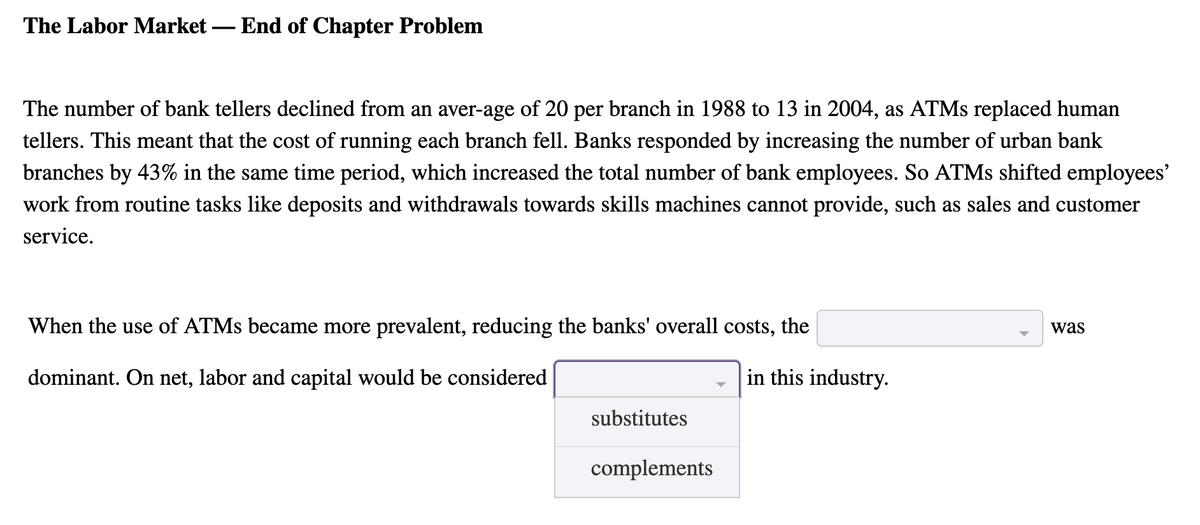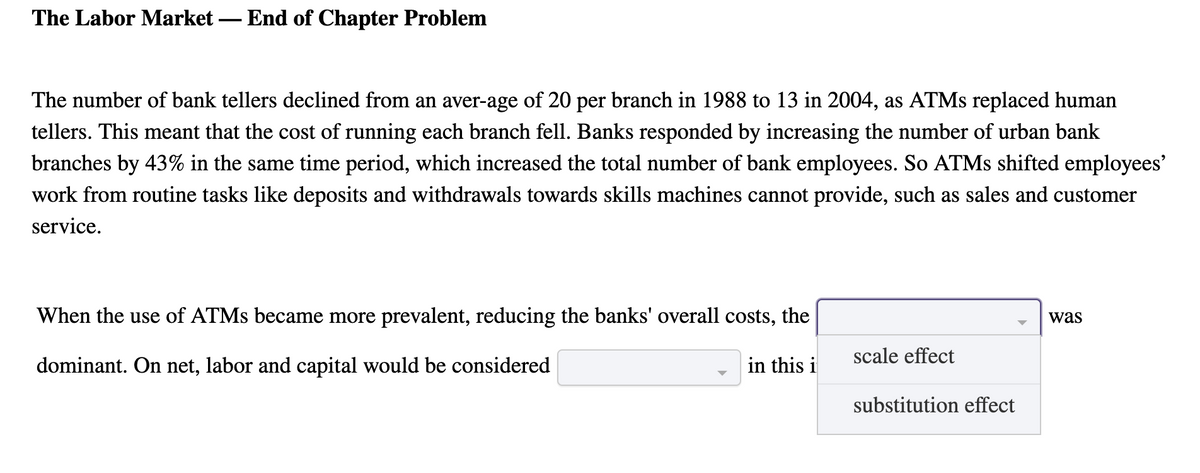The Labor Market – End of Chapter Problem The number of bank tellers declined from an aver-age of 20 per branch in 1988 to 13 in 2004, as ATMS replaced human tellers. This meant that the cost of running each branch fell. Banks responded by increasing the number of urban bank branches by 43% in the same time period, which increased the total number of bank employees. So ATMS shifted employees' work from routine tasks like deposits and withdrawals towards skills machines cannot provide, such as sales and customer service. When the use of ATMS became more prevalent, reducing the banks' overall costs, the was dominant. On net, labor and capital would be considered in this industry. substitutes complements
The Labor Market – End of Chapter Problem The number of bank tellers declined from an aver-age of 20 per branch in 1988 to 13 in 2004, as ATMS replaced human tellers. This meant that the cost of running each branch fell. Banks responded by increasing the number of urban bank branches by 43% in the same time period, which increased the total number of bank employees. So ATMS shifted employees' work from routine tasks like deposits and withdrawals towards skills machines cannot provide, such as sales and customer service. When the use of ATMS became more prevalent, reducing the banks' overall costs, the was dominant. On net, labor and capital would be considered in this industry. substitutes complements
Economics: Private and Public Choice (MindTap Course List)
16th Edition
ISBN:9781305506725
Author:James D. Gwartney, Richard L. Stroup, Russell S. Sobel, David A. Macpherson
Publisher:James D. Gwartney, Richard L. Stroup, Russell S. Sobel, David A. Macpherson
Chapter26: Earnings, Productivity, And The Job Market
Section: Chapter Questions
Problem 10CQ
Related questions
Question

Transcribed Image Text:The Labor Market
End of Chapter Problem
-
The number of bank tellers declined from an aver-age of 20 per branch in 1988 to 13 in 2004, as ATMS replaced human
tellers. This meant that the cost of running each branch fell. Banks responded by increasing the number of urban bank
branches by 43% in the same time period, which increased the total number of bank employees. So ATMS shifted employees'
work from routine tasks like deposits and withdrawals towards skills machines cannot provide, such as sales and customer
service.
When the use of ATMS became more prevalent, reducing the banks' overall costs, the
was
dominant. On net, labor and capital would be considered
in this industry.
substitutes
complements

Transcribed Image Text:The Labor Market – End of Chapter Problem
The number of bank tellers declined from an aver-age of 20 per branch in 1988 to 13 in 2004, as ATMS replaced human
tellers. This meant that the cost of running each branch fell. Banks responded by increasing the number of urban bank
branches by 43% in the same time period, which increased the total number of bank employees. So ATMS shifted employees'
work from routine tasks like deposits and withdrawals towards skills machines cannot provide, such as sales and customer
service.
When the use of ATMS became more prevalent, reducing the banks' overall costs, the
was
scale effect
dominant. On net, labor and capital would be considered
in this i
substitution effect
Expert Solution
This question has been solved!
Explore an expertly crafted, step-by-step solution for a thorough understanding of key concepts.
This is a popular solution!
Trending now
This is a popular solution!
Step by step
Solved in 2 steps

Knowledge Booster
Learn more about
Need a deep-dive on the concept behind this application? Look no further. Learn more about this topic, economics and related others by exploring similar questions and additional content below.Recommended textbooks for you

Economics: Private and Public Choice (MindTap Cou…
Economics
ISBN:
9781305506725
Author:
James D. Gwartney, Richard L. Stroup, Russell S. Sobel, David A. Macpherson
Publisher:
Cengage Learning

Microeconomics: Private and Public Choice (MindTa…
Economics
ISBN:
9781305506893
Author:
James D. Gwartney, Richard L. Stroup, Russell S. Sobel, David A. Macpherson
Publisher:
Cengage Learning


Economics: Private and Public Choice (MindTap Cou…
Economics
ISBN:
9781305506725
Author:
James D. Gwartney, Richard L. Stroup, Russell S. Sobel, David A. Macpherson
Publisher:
Cengage Learning

Microeconomics: Private and Public Choice (MindTa…
Economics
ISBN:
9781305506893
Author:
James D. Gwartney, Richard L. Stroup, Russell S. Sobel, David A. Macpherson
Publisher:
Cengage Learning



